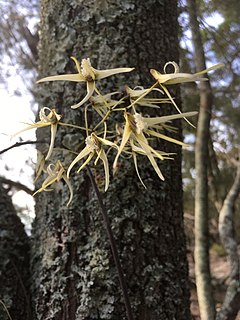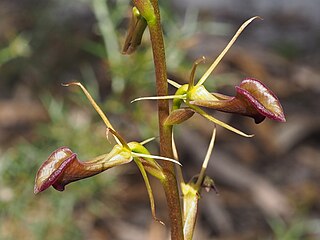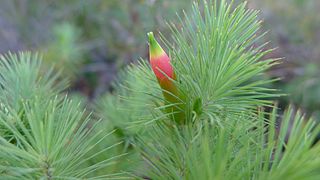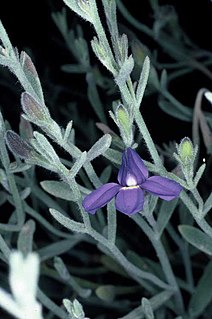
Lechenaultia is a genus of flowering plants in the family Goodeniaceae, the species native to Australia with one species also occurring in New Guinea. Plants in the genus Lechenaultia are glabrous shrubs or herbs with needle-shaped leaves, more or less sessile flowers with five sepals and five blue, white, or yellow and red petals in two unequal lobes, the fruit an elongated capsule.

Lechenaultia linarioides, commonly named yellow leschenaultia, is a species of flowering plant in the family Goodeniaceae and is endemic to near-coastal areas in the west of Western Australia. It is a sprawling subshrub with many tangled branches, narrow, crowded, rather fleshy leaves, and yellow and deep pink to purplish red flowers.

Dendrobium teretifolium, commonly known as the thin pencil orchid, rat's tail orchid or bridal veil orchid, is an epiphytic or lithophytic orchid in the family Orchidaceae. It has long, thin hanging stems, pencil-like leaves and rigid flowering stems bearing up to twelve crowded white to cream-coloured flowers. It grows in rainforest and humid open forest mostly in near-coastal districts in New South Wales and Queensland.

Orthoceras strictum, commonly known as the bird's-mouth orchid or horned orchid, is a species of orchid native to eastern and southern Australia, New Zealand and New Caledonia. It has between two and five linear leaves and up to nine yellowish green, brownish or blackish flowers with two long, erect to spreading lateral sepals.

Lechenaultia formosa, commonly known as red leschenaultia, is a species of flowering plant in the family Goodeniaceae and is endemic to the south-west of Western Australia. It is a prostrate or erect shrub or subshrub with crowded, narrow, fleshy leaves and scarlet or orange-red to pale orange flowers.

Thelymitra canaliculata, commonly called the flushed sun orchid or blue sun orchid is a species of orchid in the family Orchidaceae and is endemic to the south-west of Western Australia. It has a single erect, fleshy leaf and up to twenty eight blue flowers with darker veins and sometimes flushed with pink. The lobe on top of the anther is blackish with a yellow crest.

Cryptostylis ovata, commonly known as the slipper orchid or western tongue orchid, is an orchid endemic to Western Australia. It is a common, summer flowering species with dark green leaves with a white central vein and up to fifteen pale greenish flowers with a brownish red labellum with a network of darker veins.

Stenanthera pinifolia, commonly known as pine heath, is a species of shrub that is endemic to south-eastern Australia. It has narrow, linear leaves, yellow or red tubular flowers and a small edible berry.

Prostanthera caerulea, commonly known as lilac mint bush, is a species of flowering plant that is endemic to eastern Australia. It is an erect shrub with narrow egg-shaped leaves that have toothed edges, and white to bluish mauve flowers arranged on the ends of branchlets.

Goodenia incana is a species of flowering plant in the family Goodeniaceae and is endemic to the south-west of Western Australia. It is an ascending herb covered with silvery-white hairs, with linear to lance-shaped leaves mostly at the base of the plant, and racemes of blue flowers.

Goodenia pterigosperma is a species of flowering plant in the family Goodeniaceae and is endemic to south-coastal areas in the south-west of Western Australia. It is an erect to sprawling, glabrous perennial herb or shrub with linear to lance-shaped leaves mostly at the base of the plant, and racemes of dark blue flowers.
Goodenia quadrilocularis is a species of flowering plant in the family Goodeniaceae and is endemic to south-coastal areas in the south-west of Western Australia. It is an erect, woody perennial herb with egg-shaped to lance-shaped leaves with toothed edges, and racemes of yellow flowers.

Patersonia glabrata, commonly known as leafy purple-flag, or bugulbi in the Cadigal language, is a species of flowering plant in the family Iridaceae family and is endemic to eastern Australia. It is a perennial herb or subshrub with linear leaves and pale violet flowers.

Lechenaultia expansa is a species of flowering plant in the family Goodeniaceae and is endemic to the south-west of Western Australia. It is a prostrate to erect subshrub with wand-like branches, crowded, narrow, fleshy leaves and pale purple-blue, tube-shaped flowers.

Lechenaultia filiformis is a species of flowering plant in the family Goodeniaceae and is native to northern Australia and New Guinea. It is a grasslike, ascending herb with scattered, narrow, fleshy leaves and pale purple-blue to creamy-white, tube-shaped flowers.

Lechenaultia floribunda, commonly known as free-flowering leschenaultia, is a species of flowering plant in the family Goodeniaceae and is endemic to the south-west of Western Australia. It is an openly-branched shrub or subshrub with crowded, narrow, fleshy leaves and compact groups of pale blue to pale mauve or creamy white flowers.

Leucopogon collinus, commonly known as fringed beard-heath, is a species of flowering plant in the heath family Ericaceae and is endemic to south-eastern Australia. It is a slender, erect or spreading shrub with narrowly lance-shaped leaves, and white, tube-shaped, bearded flowers.

Leucopogon assimilis is a species of flowering plant in the family Ericaceae and is endemic to the south of Western Australia. It is an erect, slender shrub with linear or lance-shaped leaves and pink to white, tube-shaped flowers.

Epacris paludosa, commonly known as swamp heath, is a species of flowering plant from the heath family, Ericaceae, and is endemic to eastern Australia. It is an erect, bushy shrub with lance-shaped, elliptic or egg-shaped leaves and tube-shaped white or cream-coloured flowers in crowded, leafy heads at the ends of branches.

Leucopogon deformis is a species of flowering plant in the heath family Ericaceae and is endemic to eastern coastal Australia. It is a bushy shrub with narrowly egg-shaped leaves, and white, tube-shaped flowers.



















